Overview
The Channel Islands and surrounding waters support a great diversity of marine mammals, which can be divided into three groups: 1) whales, dolphins and porpoises (cetaceans); 2) seals and sea lions (pinnipeds); and 3) the southern sea otter.
Cetaceans live their entire lives at sea, while pinnipeds come ashore periodically to rest, breed, bear young, or molt. Pinnipeds depend on several haulouts and rookery sites throughout the Channel Islands. In California, sea otters normally spend their entire lives at sea, though some occasionally haul out on land. Marine mammals feed on fishes and invertebrates, which feed on other marine life in the Channel Islands region. The abundance and distribution of marine mammals is an important indication of the general health and ecological integrity of the sanctuary.
While all marine mammals are protected under the Marine Mammal Protection Act of 1972 (MMPA), some marine mammals are further protected under the federal and state Endangered Species Act. The Channel Islands provides an important habitat for at least 10 species of endangered marine mammals.
Whales, Dolphins And Porpoises
At least 33 species of cetaceans have been reported in the sanctuary region (Leatherwood et al. 1982; Leatherwood et al. 1987), of which seven are listed as endangered. Most of the reports involve live sightings although a few are known only from strandings. Common species found in the sanctuary include: Long-beaked common dolphin, Short-beaked common dolphin, Bottlenose dolphin, Pacific white-sided dolphin, Northern right whale dolphin, Risso’s dolphin, California gray whale, Blue whale, and Humpback whale. In winter and spring during the gray whale migrations, orcas are frequently reported in the region.
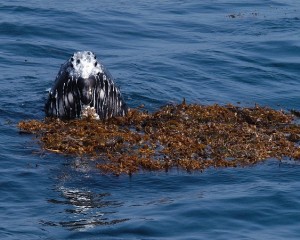
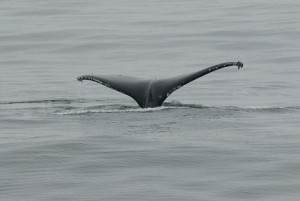
Seals and Sea Lions
The productive waters and relatively undisturbed environment of the sanctuary provides vital habitat for pinnipeds, offering important feeding areas, breeding sites, and haul-outs. Three species commonly found throughout or in parts of the sanctuary are the California sea lion, northern elephant seal, and Pacific harbor seal. Rare or uncommon species sighted within the sanctuary include the northern fur seal, the Steller sea lion and the endangered Guadalupe fur seal.
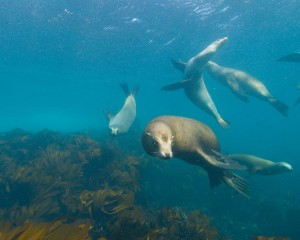
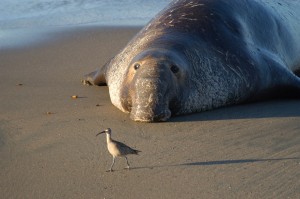
Sea Otters
Sea otters were common in the Channel Islands until prolonged periods of hunting led to local extinction at the Islands and severe depletion along the mainland California coast. After an international treaty in 1911 banned sea otter hunting, the population has increased slowly, however with drastic fluctuations due to fishing gear entanglements, disease, shark attacks, shooting, and starvation. In 2007 the USGS Western Ecological Research Center sea otter spring survey found 106 independent sea otters and zero confirmed pups south of Point Conception.
Although long-term status of the sea otter population is unclear, the geographic range of the population has expanded to the north and south. The recovering California population of sea otters now ranges from Point Conception north to Año Nuevo Island in Santa Cruz County. As a result of threats to sea otters due to their small population and limited range, a translocation project to reintroduce otters to part of their historic range was started in 1988, yet met with limited success. Between 1988 and 1990, 140 otters were translocated to San Nicholas Island and while some stayed, many swam away, died, or disappeared and were unaccounted for. As of 2010 only 46 otters were found at the San Nicholas. Sea otters are now occasionally spotted in the sanctuary, however the possibility remains that they could reestablish their range within sanctuary boundaries (USFWS 2005). The southern sea otter is listed as threatened under the federal Endangered Species Act and fully protected under California state law.
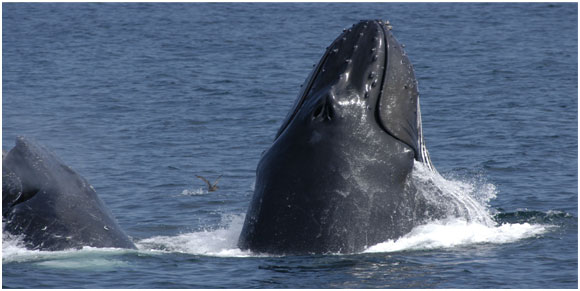
Photo: L. Gordon
Photos
Maps
Projects
Biogeographic Assessment of the Channel Islands National Marine Sanctuary
The Channel Islands National Marine Sanctuary (CINMS) off the coast of Southern California was designated in 1980. In 2005, NOAA's Office of National Marine Sanctuaries and CINMS were considering six alternatives for adjusting the sanctuary's boundaries. Identifying how the six options overlaid with the distribution of marine resources was a critical consideration. To address this need, we conducted a biogeographic assessment.
California Cooperative Oceanic Fisheries Investigations (CalCOFI)
The California Cooperative Oceanic Fisheries Investigations (CalCOFI) was formed in 1949 to study the ecological aspects of the Pacific sardine population collapse off California. Today, the focus has shifted to the study of the marine environment off the coast of California, the management of its living resources, and monitoring the indicators of El Nino and climate change.
California Lost Fishing Gear Recovery Project
The California Lost Fishing Gear Recovery Project was started in July 2005 by the SeaDoc Society (UC Davis Wildlife Health Center). Since its inception, the Project has recovered more than 100 tons of lost fishing gear and other marine debris. The California Lost Fishing Gear Recovery Project proposes to continue to help reduce the potential impact of lost fishing gear on living marine resources and underwater habitat by retrieving lost fishing gear from Channel Islands National Marine Sanctuary (CINMS) and anywhere on the coast where it is a high priority for removal because of demonstrated or potential impacts to marine wildlife and people. 1-888-491-GEAR to report lost, abandoned, and discarded gear.
Channel Islands Naturalist Corps
Channel Islands Naturalist Corps volunteers are trained by CINMS and CINP to educate the public on board local marine excursion vessels conducting whale watch tours, natural history tours, and island trips. Channel Islands Naturalist Corps volunteers are trained to conduct citizen science on marine mammal field identification and general research. Research objectives of the program include the development of a comprehensive database of incidental marine mammal sightings and reports collected in the Santa Barbara Channel, CINMS and CINP.
CINMS Soundscape monitoring
Biological, geophysical, and anthropogenic sound sources all combine to make up an underwater acoustic environment, or “soundscape.” Because ocean water conducts light very poorly and conducts sound very well, many marine organisms rely on sound for communication, navigation, reproduction, and foraging. Using a network of moored hydrophones around the sanctuary, we can examine how soundscapes vary at each location and across sanctuary habitats.
Developing near real-time passive acoustic detection capability for mitigating ship strikes in the Southern California Bight
Woods Hole Oceanographic Institution and the Benioff Ocean Initiative are piloting a passive acoustic monitoring system to detect, classify, and report whale calls (blue, humpback, and fin) in near real time from a fixed autonomous platform in the Santa Barbara Channel, and provide these detections for use by managers.
Long-term monitoring using ocean noise reference stations
The objective of this project is to establish a NOAA-operated network of ten ocean noise reference stations (ONRS) in US waters to monitor long-term changes and trends in the underwater ambient sound field.
Monitoring Shipping Noise in the Santa Barbara Channel
Simultaneous AIS (Automatic Information System) ship tracking data and underwater hydrophone data have been collected in the Santa Barbara Channel since 2007. These data allow measurement of the source level of individual vessels transiting through the Santa Barbara Channel.Monitoring whales by Cascadia Research Collective
Cascadia Research is a non-profit (501c3) scientific and education organization based in Olympia, Washington, USA. We primarily conduct research needed to manage and protect threatened marine mammals.Photo-identification of Blue Whales
The focus of this project is to collect identification photographs of blue whales to examine movements, migratory destinations, stock structure, and behavior, and to estimate abundance and trends in abundance.Pinniped Aerial Surveys
The Pinniped Aerial Surveys Project conducts censuses of five species of pinnipeds (i.e., seals, sea lions, and fur seals) for monitoring trends and abundance of populations found in the United States. Pups and other age/sex classes are counted from color photographs taken at rookeries and haulouts during aerial surveys of islands and the mainland coast of California. Surveys are conducted in February for elephant seals (Mirounga angustirostris), May through July for harbor seals (Phoca vitulina richardii), and July for California sea lions (Zalophus californianus), Steller sea lions (Eumetopias jubatus), and northern fur seals (Callorhinus ursinus). Surveys are also conducted opportunistically at selected California sea lion rookeries in Baja California, Mexico during late-July and early-August.
Sanctuary Aerial Monitoring and Spatial Analysis Program
Sanctuary Aerial Monitoring and Spatial Analysis Program (SAMSAP) was a long-term aerial monitoring program that collected data on vessel and visitor use patterns as well as cetacean populations within CINMS. It provided vital data for management, research, and emergency response needs.Systematic Marine Mammal Aerial Surveys to Guide Conservation of Endangered Whales in the Santa Barbara Channel Region
NOAA Channel Islands National Marine Sanctuary seeks to (1) maintain consistent marine mammal aerial monitoring to improve our understanding of endangered baleen whale species’ distribution and (2) apply these findings to better inform conservation management actions in the Santa Barbara Channel Region.
Tagging of Pacific Predators (TOPP)
The Tagging of Pacific Pelagics (TOPP) research program aims to understand the migration patterns of large predators in the North Pacific basin and how these animals act and interact in their open ocean habitats. By using satellite tagging techniques, TOPP researchers follow the movements of different species across multiple trophic levels (i.e., the food web) and in relation to physical oceanographic features in order to piece together a whole ecosystem picture.Underwater Behavior of Large Whales Using Suction-cup Attached Tags
This project examined underwater movements, behavior, and vocalizations of individual blue, fin, and humpback whales using suction-cup tags. Tags included a variety of instrument packages.Links
Año Nuevo State Park - Northern Elephant Seals
California State Parks website for Año Nuevo, the site of the largest mainland breeding colony in the world for the northern elephant seal.http://www.parks.ca.gov/default.asp?page_id=523
American Cetacean Society - Monterey Bay Chapter
Find out more about what the local chapter of the American Cetacean Society does to expand scientific knowledge of these fascinating creatures.http://www.acsmb.org/
David's Whale and Dolphin Watch
Image library with many whale and dolphin images, organzied by species. Site also provides links to other pages.http://neptune.atlantis-intl.com/dolphins/index.html
Defenders of Wildlife - Sea Otter educational unit
This unit focuses on sea otters of California, Oregon, and Washington and is available in English and Spanish.http://www.kidsplanet.org/espanol/espint.html
Discovery of Sound in the Sea
This web site will introduce you to the science and uses of sound in marine research.http://omp.gso.uri.edu/dosits/dosits.htm
Lawrence Hall of Science (UC Berkeley) - Whale Sounds
Online whale sound activity that includes recorded whale sounds and discusses communication and echolocation, the term that describes how many marine mammals "see with sound" underwater.http://lhs.berkeley.edu/WHALE
List of links provided by SeaWorld
SeaWorld and Walt Disney World provide a list of links with Orca information.http://www.orlandofuntickets.com/the-sea-life-of-orca-whales.php
List of Marine Mammal Species and Subspecies
The Ad-Hoc Committee on Taxonomy, chaired by Bill Perrin, has produced the first official Society of Marine Mammology list of marine mammal species and subspecies. Consensus on some issues was not possible; this is reflected in the footnotes.http://www.marinemammalscience.org/index.php?option=com_content&view=article&id=420&Itemid=280
MARE: Marine Activities, Resources and Education
MARE is an interdisciplinary science program at the Lawrence Hall of Science (UC Berkeley) offering year-round professional development opportunities, including events that immerse your whole school—faculty, students and families—in the study and celebration of the ocean.http://www.lawrencehallofscience.org/MARE/
Monterey Bay Aquarium - Student and Teacher Resources and Activities
The Monterey Bay Aquarium offers teacher and student resources including: species and habitat-specific information, live cams, classroom activities, and interactive online games.http://www.mbayaq.org/lc/
Monterey Bay National Marine Sanctuary - Marine Mammals
A comprehensive and educational scientific characterization of important creatures in the Monterey Bay Sanctuary.http://montereybay.noaa.gov/sitechar/mamm.html
Monterey Bay National Marine Sanctuary - Slideshow
Slideshow that includes photos of landscapes, marine mammals, birds and other organisms found in the Monterey Bay.http://montereybay.noaa.gov/visitor/slideshow/slideshow.html
Monterey Bay Whale Watch - Marine Life of the Bay
Photos and brief descriptions about local marine mammals and other marine wildlife from the Monterey Bay.http://www.montereybaywhalewatch.com/marlife.htm
Monterey Bay Whale Watch - Marine Mammal Sightings in the Monterey Bay Region
View a list of the most recent marine mammal sightings logged by Monterey Bay Whale Watch. This list is constantly updated.http://www.montereybaywhalewatch.com/sighting.htm
National Marine Mammal Laboratory
The National Marine Mammal Laboratory (NMML) conducts research on marine mammals worldwide, concentrating primarily in coastal California, Oregon, Washington and Alaska.http://nmml.afsc.noaa.gov/
NOAA National Marine Mammal Laboratory
Marine Mammal Education Web hosted by NOAA's Alaska Fisheries Science Center.http://www.afsc.noaa.gov/nmml/education/marinemammals.php
NOAA Photo Library
NOAA's photo library contains incredible shots of an amazing array of animals, technology, scientists, and images of historical treasures. Site also offers search function for images.http://www.photolib.noaa.gov
OBIS-SEAMAP: Ocean Biological Information System - Spatial Ecological Analysis of Megavertebrate Populations
A digital database of marine mammal, seabird, and sea turtle distribution and abundance. The web-based system will allow the interactive display, query, and analysis of the digital archive in conjunction with environmental data.http://seamap.env.duke.edu/
Save the Whales
Save The Whales is a non-profit organization whose mission is to educate children and adults about marine mammals, their environment and their preservation. Save the Whales is based in Monterey, and their website provides information on free class presentations, Adopt-A-Whale programs and general information about local marine mammals.http://savethewhales.org
SLEWTHS: Science Learning and Experimenting with the Help of Sea Lions
Research project that studies marine mammals, with sea lions and people working together. Sponsored by Moss Landing Marine Lab, the program also offers classes, internships and other learning opportunities.http://slewths.mlml.calstate.edu/
SORAC: Sea Otter Research and Conservation
Find out what the Monterey Bay Aquarium is doing to learn more about how to conserve the California sea otter.http://www.mbayaq.org/cr/sorac.asp
Tagging of Pacific Predators: near real-time animal tracks
Images of near real-time satellite tracking data of pelagic species of sharks, mammals, and turtles.http://topp.org/
The Marine Mammal Center
Learn more about an organization that rescues, rehabilitates, releases, teaches about and researches marine mammals.http://www.marinemammalcenter.org/
The Otter Project
The Otter Project exists to promote the rapid recovery of the California sea otter, an indicator of near shore ocean health, by facilitating research and communicating research results to the general public and policy makers.http://www.otterproject.org
USGS Western Ecological Research Center - Sea Otter Research
The U.S. Geological Survey Western Ecological Research Center (USGS WERC) maintains expertise on sea otters in California, Washington, and Alaska, and works with state, federal, and local partners throughout the species' range. The Center, located in Santa Cruz, is the repository for data on both the threatened California sea otter population and the state-listed Washington sea otter population.http://www.werc.usgs.gov/project.aspx?projectid=91
Whale Acoustics
A company that works with federal agencies to study man-made noise impacts on whales and the use of passive acoustics to develop census methods for whales.http://www.whaleacoustics.com
Whale sightings by Sanctuary Cruises
The Captain's log is the latest in whale sightings information in Monterey Bay as collected by Sanctuary Cruises.https://sanctuarycruises.com/captains_log/
WhaleNet
WhaleNet is an interdisciplinary, student-centered, interactive educational program focused on whales, the marine habitat, and environmental studies. Some activities are available on-line, some can be ordered for an additional charge.http://whale.wheelock.edu/Welcome.html
WhaleNet Guide to Whales & Marine Mammals of the North Atlantic Ocean
CDROM with educational materials on Marine Mammals of the North Atlantic.http://whale.wheelock.edu/whalenet-stuff/CDROMintro.html